All AbMole products are for research use only, cannot be used for human consumption.

Axitinib blocked phosphorylation of VEGFR-2 and VEGFR-3 with average IC50s of 0.2 and 0.1 to 0.3 nM.Axitinib (also known as AG013736) is a small molecule tyrosine kinase inhibitor.It inhibits multiple targets, including VEGFR-1, VEGFR-2, VEGFR-3, platelet derived growth factor receptor (PDGFR), and cKIT (CD117). It has been shown to significantly inhibit growth of breast cancer in xenograft models and has been successful in trials with renal cell carcinoma (RCC) and several other tumor types.

J Virol. 2020 Feb 14;94(5):e01791-19.
Targeting Kaposi's Sarcoma-Associated Herpesvirus ORF21 Tyrosine Kinase and Viral Lytic Reactivation by Tyrosine Kinase Inhibitors Approved for Clinical Use
Axitinib purchased from AbMole

Oncol Res. 2019 Sep 23;27(9):987-995.
Nutlin-3-Induced Sensitization of Non-Small Cell Lung Cancer Stem Cells to Axitinib-Induced Apoptosis Through Repression of Akt1/Wnt Signaling.
Axitinib purchased from AbMole

Int J Cancer. 2017 May 1;140(9):2150-2161.
Complementary actions of dopamine D2 receptor agonist and anti-vegf therapy on tumoral vessel normalization in a transgenic mouse model
Axitinib purchased from AbMole
| Cell Experiment | |
|---|---|
| Cell lines | HUVEC, SH-SY5Y, IGR-N91 and IGR-NB8 cell lines |
| Preparation method | MTS cell proliferation assay HUVEC, SH-SY5Y, IGR-N91 and IGR-NB8 cell lines were seeded at 5,000 cells per well in a 96-well plate and left to settle overnight in EMBV R-2 or DMEM with 10% fetal calf serum. The cells were treated with axitinib at concentrations ranging from 1 nmol/l to 10 lmol/l. Cell viability was determined after 72 hr using MTS tetrazolium substrate (CellTiter 96 Aqueous One Solution Cell Proliferation Assay; Promega Corporation, Charbonnieres, France) and colorimetric measurement at 490 nm in an automatic plate reader (Elx808; Fisher Bioblock Scientific SAS, Illkirch, France). IC50 values were calculated using GraphPadV R Prism software (version 3.00). |
| Concentrations | 1 nM - 10 μM |
| Incubation time | 72 hr |
| Animal Experiment | |
|---|---|
| Animal models | IGR-N91 xenografts with female SPF-Swiss athymic nude mice at 6–8 weeks of age |
| Formulation | 0.5% CMC |
| Dosages | 30 mg/kg BID for 2 weeks |
| Administration | oral gavage |
| Molecular Weight | 386.47 |
| Formula | C22H18N4OS |
| CAS Number | 319460-85-0 |
| Solubility (25°C) | DMSO ≥ 20 mg/mL |
| Storage |
Powder -20°C 3 years ; 4°C 2 years In solvent -80°C 6 months ; -20°C 1 month |
| Related VEGFR/PDGFR Products |
|---|
| SU5208
SU5208 inhibits vascular endothelial growth factor receptor-2 (VEGFR2). |
| VEGFR-IN-1
VEGFR-IN-1 is a potent angiogenesis inhibitor with IC50s of 0.02, 0.18, 0.24 7.3, and 7 µM for KDR, Flt-1, c-Kit, EGF-R, and c-Src, respectively. |
| (Z)-Orantinib
(Z)-Orantinib ((Z)-SU6668) is a potent, selective, orally active and ATP competitive inhibitor of Flk‐1/KDR, PDGFRβ, and FGFR1, with IC50s of 2.1, 0.008, and 1.2 µM, respectively. |
| (Rac)-SAR131675
(Rac)-SAR131675 is the racemate of SAR131675. |
| AGL 2043
AGL 2043 is an effective inhibitor of PDGFR (IC50=0.8 μM) and TEL-PDGFR kinases, as well as FLT3 and KIT kinases. |
All AbMole products are for research use only, cannot be used for human consumption or veterinary use. We do not provide products or services to individuals. Please comply with the intended use and do not use AbMole products for any other purpose.


Products are for research use only. Not for human use. We do not sell to patients.
© Copyright 2010-2024 AbMole BioScience. All Rights Reserved.
